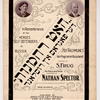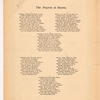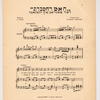4: Poem and song, Simon Frug’s “Have Pity,” 1906.
When we place Bialik’s text in the context of other poetic reactions to the Kishinev Pogrom, we begin to see that his real target was not the victims themselves but the way that some Jewish leaders and intellectuals had taken to writing about Jewish suffering as though there was something noble about it. Bialik was attacking a martyrdom ideal that made a virtue out of suffering rather than making efforts to relieve it. Take a look at another poetic response to the Kishinev pogrom by the then-famous Russian- and Yiddish-language poet Simon Frug. This Yiddish poem, called "Hot rakhmones" or “Have Pity,” was published on the front page of one Yiddish-language daily newspaper, the Petersburg Fraynd, soon after the pogrom, and it quickly became famous. By the time Bialik wrote “In the City of Slaughter,” “Have Pity” had been set to music and become widely known.
Suggested Activities: Compare Bialik’s treatment of the discourse of the victims in the aftermath of the pogrom to that of Frug. To whom has Frug addressed his poem? What do you think Frug hopes readers will do after encountering his piece? Have students think about more recent instances of violence and suffering. Can they think of any artistic responses to such events? If so, ask them to analyze those responses, asking the same questions they've asked about Frug and Bialik's poems.
Sources: Nathan L. Spector and Samuel Frug. Hot rachmunes, der pogrom in Russland In Remembrance of the Heroes, Self Defenders in Russia. Spector, Getter & Co., New York, 1906, 1–3. Accessed at https://www.loc.gov/item/ihas.200154952/.
Simon Frug Cover
 Download image (392.21 KB)
Download image (392.21 KB) Simon Frug Text
 Download image (325.88 KB)
Download image (325.88 KB) Simon Frug Music
 Download image (274.73 KB)
Download image (274.73 KB)



